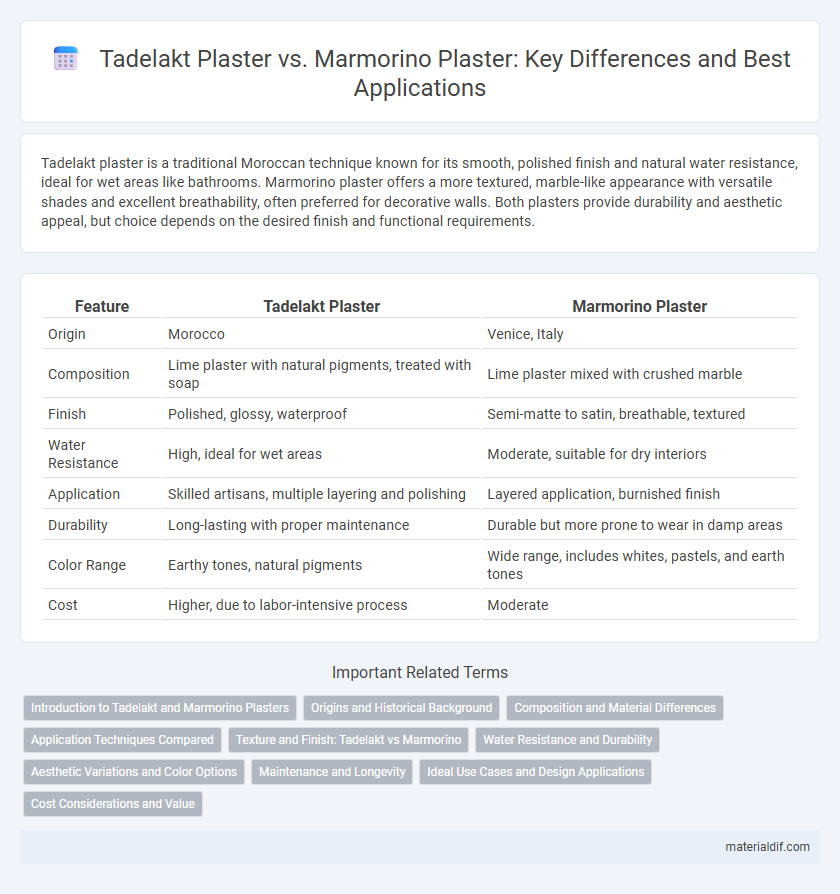Tadelakt plaster is a traditional Moroccan technique known for its smooth, polished finish and natural water resistance, ideal for wet areas like bathrooms. Marmorino plaster offers a more textured, marble-like appearance with versatile shades and excellent breathability, often preferred for decorative walls. Both plasters provide durability and aesthetic appeal, but choice depends on the desired finish and functional requirements.
Table of Comparison
| Feature | Tadelakt Plaster | Marmorino Plaster |
|---|---|---|
| Origin | Morocco | Venice, Italy |
| Composition | Lime plaster with natural pigments, treated with soap | Lime plaster mixed with crushed marble |
| Finish | Polished, glossy, waterproof | Semi-matte to satin, breathable, textured |
| Water Resistance | High, ideal for wet areas | Moderate, suitable for dry interiors |
| Application | Skilled artisans, multiple layering and polishing | Layered application, burnished finish |
| Durability | Long-lasting with proper maintenance | Durable but more prone to wear in damp areas |
| Color Range | Earthy tones, natural pigments | Wide range, includes whites, pastels, and earth tones |
| Cost | Higher, due to labor-intensive process | Moderate |
Introduction to Tadelakt and Marmorino Plasters
Tadelakt plaster, a traditional Moroccan lime-based finish, creates a smooth, water-resistant surface with a subtly glossy sheen ideal for bathrooms and fountains. Marmorino plaster, originating in Italy, combines lime and crushed marble for a durable, matte or satin finish that mimics natural stone textures. Both plasters offer breathable, eco-friendly options but differ in texture, application techniques, and moisture resistance suitable for various architectural aesthetics.
Origins and Historical Background
Tadelakt plaster originates from Morocco, dating back to the 12th century as a traditional waterproof plaster used in hammams and palaces, recognized for its natural marble-like finish achieved through a unique lime-based technique. Marmorino plaster, rooted in ancient Roman and Venetian architecture, has been utilized since antiquity, prized for its smooth, polished appearance derived from natural lime and marble dust, often seen in Renaissance buildings. Both plasters reflect rich cultural heritages and artisanal craftsmanship but differ significantly in their regional origins and historical applications.
Composition and Material Differences
Tadelakt plaster is a traditional Moroccan lime-based plaster mixed with natural pigments and olive oil soap, creating a smooth, waterproof surface prized for its durability and polished finish. Marmorino plaster, originating from Italy, combines lime putty with crushed marble dust, offering a matte or satin texture that mimics natural stone with breathable, moisture-resistant properties. The primary material difference lies in Tadelakt's emphasis on a soap-treated lime base for water repellency, while Marmorino's marble content enhances texture and aesthetic versatility.
Application Techniques Compared
Tadelakt plaster requires a unique application technique involving multiple layers that are polished with a stone to achieve a smooth, water-resistant finish ideal for wet areas like bathrooms. Marmorino plaster involves applying a basecoat followed by a thinner finishing coat, which is then burnished with a steel trowel to create a textured, marble-like surface. Both techniques demand skilled artisanship, but Tadelakt's labor-intensive polishing contrasts with Marmorino's emphasis on controlled layering and burnishing for durability and aesthetic depth.
Texture and Finish: Tadelakt vs Marmorino
Tadelakt plaster features a smooth, polished finish with a subtle sheen achieved through meticulous burnishing, creating a waterproof surface ideal for bathrooms and wet areas. Marmorino plaster offers a textured, matte to semi-gloss finish with a slightly rougher feel, delivering a natural stone appearance that enhances wall depth and character. Both materials provide durable, breathable surfaces, but Tadelakt's unique lime-based treatment results in a more lustrous and impermeable texture compared to Marmorino's velvety and mineral-rich finish.
Water Resistance and Durability
Tadelakt plaster offers exceptional water resistance due to its lime-based composition and polished finish, making it ideal for wet environments like bathrooms and fountains. Marmorino plaster, while durable and breathable, provides moderate water resistance but excels in flexibility and crack prevention. Both materials showcase long-lasting durability, with Tadelakt favored for moisture-heavy applications and Marmorino preferred for decorative indoor surfaces.
Aesthetic Variations and Color Options
Tadelakt plaster offers a smooth, glossy finish with subtle undulations, creating a luxurious, polished look often found in traditional Moroccan architecture, and is typically available in earthy tones such as ochre, terracotta, and soft greens. Marmorino plaster provides a matte to satin finish with a slightly textured, marble-like appearance, allowing for more diverse color customization, including whites, grays, blues, and pastels, ideal for Mediterranean-inspired interiors. Both plasters allow for unique aesthetic variations through polishing and layering techniques, but Tadelakt emphasizes depth and sheen, while Marmorino highlights texture and color versatility.
Maintenance and Longevity
Tadelakt plaster requires regular sealing with natural soap to maintain its waterproof finish and prevent staining, making its upkeep more involved than Marmorino plaster. Marmorino plaster is highly durable, resistant to moisture, and demands less frequent maintenance, offering greater longevity in high-traffic or humid environments. Both finishes benefit from proper care, but Marmorino's resistance to wear and simpler upkeep makes it preferable for long-term durability and ease of maintenance.
Ideal Use Cases and Design Applications
Tadelakt plaster, known for its waterproof and glossy finish, is ideal for wet areas such as bathrooms, kitchens, and fountains where moisture resistance and smooth aesthetics are crucial. Marmorino plaster offers a matte, textured finish with excellent breathability, making it suitable for interior walls, ceilings, and decorative features in dry environments. Both materials provide natural lime-based solutions, but Tadelakt excels in high-humidity zones while Marmorino enhances visual depth in living spaces.
Cost Considerations and Value
Tadelakt plaster generally costs more than Marmorino plaster due to its labor-intensive application and the use of natural lime and soap sealant, which enhance its waterproof properties and durability. Marmorino plaster offers a more budget-friendly option with its faster application process and decorative versatility, making it suitable for larger surface areas without compromising aesthetic appeal. While Tadelakt provides superior long-term value in high-moisture environments like bathrooms, Marmorino balances cost efficiency and visual elegance for diverse interior and exterior walls.
Tadelakt Plaster vs Marmorino Plaster Infographic

 materialdif.com
materialdif.com